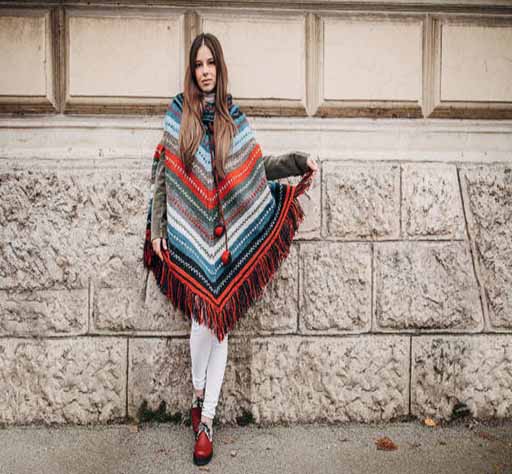Ponchos in 2004: A Fashion Staple with Versatile Appeal
Ponchos in 2004 emerged as a fashion staple with versatile appeal, offering both style and functionality. This garment, characterized by its loose-fitting silhouette and typically made from warm and cozy materials, gained popularity in various fashion circles, from casual wear to high-end designer collections. In 2004, the poncho trend saw a resurgence, with updated designs and modern interpretations reflecting the fashion sensibilities of the era.
Evolution of the Poncho Trend in 2004
- Traditional Inspiration: The poncho trend in 2004 drew inspiration from traditional South American and Native American garments, which featured loose, draped silhouettes crafted from woven textiles. These traditional ponchos were worn for warmth and protection from the elements, often adorned with intricate patterns or embellishments.
- Modern Interpretations: In 2004, designers put a modern spin on the classic poncho, reimagining it as a versatile and fashionable garment for contemporary wardrobes. This included variations in silhouette, length, and fabric, as well as experimentation with colors, patterns, and textures. From sleek and minimalist designs to bold and statement-making pieces, the poncho trend offered something for every style preference.
- High-Fashion Influence: The poncho trend in 2004 also made its mark on high-end fashion runways, with designers incorporating ponchos into their collections as chic and sophisticated outerwear options. Luxury brands reinterpreted the poncho with premium materials and elevated craftsmanship, elevating it from a casual staple to a fashion-forward statement piece.
Styles and Silhouettes
- Classic Poncho: The classic poncho silhouette featured a square or rectangular shape with an open front and draped sides, offering ease of movement and layering. In 2004, this timeless silhouette was updated with modern touches such as asymmetrical hemlines, fringe trim, or decorative stitching, adding visual interest and depth to the garment.
- Cape-style Poncho: Cape-style ponchos emerged as a popular variation in 2004, featuring a longer length and a more structured silhouette that resembled a cape. These ponchos often had armholes or slits for added functionality, allowing for ease of movement while maintaining a sleek and sophisticated appearance.
- Knit Poncho: Knit ponchos became synonymous with the poncho trend in 2004, offering warmth and coziness during the colder months. These ponchos were crafted from soft and textured yarns, ranging from chunky cable knits to finer gauge stitches. They were often adorned with cable patterns, ribbed trims, or tassel details, adding a touch of artisanal charm to the garment.
Fabrics and Details
- Wool and Cashmere: Wool and cashmere were the predominant fabrics used for ponchos in 2004, prized for their warmth, softness, and luxurious feel. These natural fibers offered excellent insulation against the cold, making them ideal for winter outerwear. Wool ponchos came in a variety of weights and textures, from lightweight merino to chunky lambswool, while cashmere ponchos exuded luxury and sophistication.
- Fringe and Tassel Trim: Fringe and tassel trim were popular embellishments on ponchos in 2004, adding movement and visual interest to the garment. These decorative details adorned the edges of ponchos, creating a bohemian-inspired aesthetic that was both playful and stylish. Fringe and tassel trim came in varying lengths and densities, allowing for customization and personalization of the poncho.
- Prints and Patterns: Prints and patterns played a significant role in the poncho trend in 2004, offering a range of options for adding personality and flair to the garment. Traditional Southwestern motifs, geometric designs, and tribal-inspired patterns were prevalent, reflecting the poncho’s cultural heritage. Additionally, bold stripes, abstract prints, and floral motifs added a contemporary twist to poncho designs, catering to modern fashion sensibilities.
Styling and Accessories
- Layering Essentials: Ponchos in 2004 were versatile layering pieces that could be styled in numerous ways to suit different occasions and outfits. They could be worn over basic tees and jeans for a casual daytime look or layered over dresses and skirts for a more polished and sophisticated ensemble. Belted ponchos cinched at the waist added definition and structure to the silhouette, while oversized ponchos draped effortlessly over the body for a relaxed and effortless vibe.
- Accessories: Accessories played a key role in styling ponchos in 2004, adding the finishing touches to the ensemble. Wide-brimmed hats, such as fedoras or floppy hats, complemented the bohemian aesthetic of ponchos, while scarves and wraps provided additional warmth and texture. Statement jewelry, such as chunky necklaces or stacked bangles, added a touch of glamour and personality to the outfit, elevating the overall look.
Overall, the poncho trend in 2004 offered a diverse range of styles, fabrics, and details, catering to different tastes and preferences among fashion enthusiasts. Whether as a casual layering piece or a high-fashion statement, the poncho remained a versatile and fashionable garment that captured the spirit of the era.











